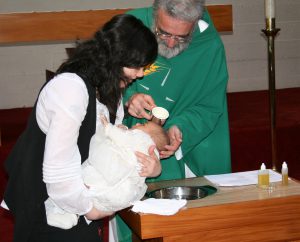WelCom’s ‘Catholic Thinking’ series presents articles by lecturers from New Zealand’s Catholic Tertiary providers, Good Shepherd Theological College and The Catholic Institute. TCI’s Susan Wilson explores Baptism and Catechesis.
Catechesis and the Rite of Baptism
“Essentially catechesis is about knowing, doing and loving – these three elements come together to shape faith in a loving God and response to others and the world.”
In their journey to be received into the Church, these new Catholics have undertaken a number of preparatory steps.One of the many significant joys during the Easter season is the welcoming of new Catholics (known as ‘neophytes’) who have to become members of the Church.
- They have participated in the RCIA – the Rite of Christian Initiation of for Adults who wish to become Catholics.
- They have been through the catechumenate – the period of learning about the Catholic faith before Baptism.
- During Lent, as part of the RCIS process, they have been through purification and enlightenment – a time of reflection and scrutiny.
- After being received into the Church, these new Catholics are now in the mystagogy stage of the RCIA. Mystagogy means to ‘lead through the mysteries’, which begins after the new Catholic is received into the Church at Easter and continues until Pentecost. The new Catholics are accompanied as they discover what it means to fully participate in the sacramental mysteries of the Church.
Most of us sitting at Mass at Easter will only have a vague understanding of the full process of RCIA. The vast majority of Catholics were baptised into the Catholic faith as babies without any understanding and so have not participated in the catechumenate. Whereas, those received into the Church as adults do so after catechesis (religious formation and education) in the Catholic faith and after much prayer and reflection. This difference is reflected in the liturgy.
Baptism Liturgy
The present Rite of Baptism for Children was promulgated in 1969, three years before the Rite of Christian of Initiation for Adults in 1972. Both these revised rites are a result of the Vatican II Constitution, Sacrosanctum Concilium, whose purpose was ‘to (undertake) the reform and promotion of the liturgy’ (SC1).
Two purposes were identified when the rite for children was being reformed
1. To make it clear in the rite the recipients were infants, not adults; and
2. To include the roles and duties of parents and godparents in the rite itself (SC 67).
The process of reforming the rite for adults began in 1962 when the Congregation of Rites decreed adult baptism was to be carried out in stages paving the way for the RCIA. (The Congregation of Rites was a congregation in Rome that supervised liturgy, sacraments and canonisations. It was reassigned
in 1969.)
The decree in 1962 was preceded by the establishment of the adult catechumenate in various missionary territories from 1534 and was also a return to the practice of the Early Church.
So how does the rite of Baptism for children reflect the recipients are infants and how are the duties of parents and godparents made clear in the rite?
Baptism of Children
There are four main parts in the Rite of Baptism for Children.
1. The liturgy of the Word – scripture reading and homily, intercessions, prayer of exorcism and anointing before Baptism.
2. Celebration of the sacrament – blessing and invocation of God over baptismal water, renunciation of sin and profession of faith, Baptism.
3. Explanatory rites – anointing after Baptism, clothing with white garment, lighted candle, ephphetha (prayer over ears and mouth).
4. Conclusion of the rite – Lord’s prayer, blessing and dismissal.

Held by his mother Jenny, Eliot McCairn is being baptised by celebrant Fr Kevin Connors. During this part of the rite water is poured over Eliot’s head and he is baptised ‘in the name of the Father, and of the Son and of the Holy Spirit’. Photo: Supplied
In part one, you may be surprised to see there is a ‘prayer of exorcism’. There are two categories of exorcism in the Catholic faith. The first is a simple or minor exorcism, as found in Baptism, which is used to remove influences of evil and sin. The second category is major exorcism. This prayer prays to ‘set (name) free from original sin’.
The duties of the parents and godparents are highlighted in the ‘Renunciation of Sin and Profession of Faith’. Here the celebrant entrusts the parents and godparents with the task to nurture the divine life God gives their child. The parents and godparents do not make renunciations or professions on the child’s behalf. They, along with the congregation, renounce Satan and profess their own faith in Father, Son and Spirit. The child, who is too young to have faith, is baptised into the faith of the Church. The parents in the first instance, then the godparents and the whole community, are responsible to assist the child to grow in faith.
So, unlike our new Catholics in the RCIA, catechesis for those of us born Catholic happens after Baptism. Our parents are our first catechists. We gain more formal catechesis when preparing to receive the other sacraments of initiation: Eucharist and Confirmation.
Essentially, catechesis is about knowing, doing and loving. These three elements come together to shape a child’s faith in a loving God and their response to others and the world. The primary reason the Church has a wide network of schools is to education children in the faith of the Church. As adults, there are also many opportunities to deepen our knowledge of the mystery of God.
Susan Wilson is Head of Student and Business Support at The Catholic Institute.

